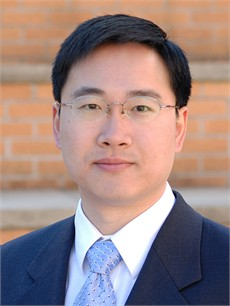
报告题目:Controlling the surface property of nanomaterials for cancer and autoimmune diseases
Abstract: Nanomaterials have broad biomedical applications. Although their physicochemical properties such as shape, size, elasticity and surface chemical composition are known to be pivotal in the design of nanomedicines. The impact of dynamic topographical structure of nanomaterials has not been studied. In this talk, I will show the importance of this new parameter for nanomedicine design. We have found that nanomaterials blood circulation time could be dramatically extended by controlling the dynamic topographical structure of polyethylene glycol (PEG) shell on nanoparticles. Regular high density PEG shell does not have this effect. Surprisingly, our studies reveal that the dynamic effect extends nanoparticle blood circulation via reduced nanoparticle uptake by liver sinusoidal endothelial cells (LSECs) instead of macrophages. The dynamic PEG layers reduce protein binding affinity to nanoparticles. This property can be used to enhance nanoparticle penetration in mucus. One of the major challenges of nanomedicines in cancer therapy is the inefficient diffusion of drug nanocarriers in solid tumors due to the high density of extracellular matrix in tumors. One old strategy is to conjugate matrix degrading enzymes on nanoparticle surfaces as the enzymes remove barriers for nanoparticle diffusion. However, successful animal studies have not been demonstrated. One reason is the conjugation of bioactive molecules on nanoparticle surfaces often reduces their blood circulation. We show that the problem can be circumvented by embedding matrix degrading enzymes in the PEG shell with dynamic structure instead of presenting the enzymes on the outmost surface of nanoparticles. The effects of prolonged nanoparticle blood circulation and enhanced diffusion in solid tumors dramatically increased nanoparticle accumulation and penetration in tumors, leading to a highly efficient antitumor efficacy. Thus, our platform technology of controlling topographical structure of nanocarriers may be valuable to enhance the clinical efficacy of a broad range of drug nanocarriers. In addition, I will briefly discuss how the surface property of nanoparticle is critical in the induction of antigen-specific immune tolerance for treating autoimmune diseases.
报告时间:2019年8月30日(周五)下午14:30
报告地点:高新大厦15楼会议室2
报告人:Dr. Hao Cheng
Dr. Hao Cheng is currently an Associate Professor in the Department of Materials Science & Engineering at Drexel University, and affiliated faculty member in the School of Biomedical Engineering, Science, and Health Systems. He received his B.E. and M.S. degrees in Chemical Engineering from Tsinghua University in China, and his Ph.D. degree in Materials Science & Engineering from Northwestern University. He was a postdoctoral associate in cancer biology at Northwestern University, and Koch Institute for Integrative Cancer Research and Department of Chemical Engineering at MIT. He has published 30 papers in Journals such as PNAS, Nano Letters, ACS Nano, Advanced Materials, and Biomaterials. His current research focuses on the investigation of fundamental nanomaterial-cell interactions and the development of new biomaterials for immunotherapy.
Abstract: Nanomaterials have broad biomedical applications. Although their physicochemical properties such as shape, size, elasticity and surface chemical composition are known to be pivotal in the design of nanomedicines. The impact of dynamic topographical structure of nanomaterials has not been studied. In this talk, I will show the importance of this new parameter for nanomedicine design. We have found that nanomaterials blood circulation time could be dramatically extended by controlling the dynamic topographical structure of polyethylene glycol (PEG) shell on nanoparticles. Regular high density PEG shell does not have this effect. Surprisingly, our studies reveal that the dynamic effect extends nanoparticle blood circulation via reduced nanoparticle uptake by liver sinusoidal endothelial cells (LSECs) instead of macrophages. The dynamic PEG layers reduce protein binding affinity to nanoparticles. This property can be used to enhance nanoparticle penetration in mucus. One of the major challenges of nanomedicines in cancer therapy is the inefficient diffusion of drug nanocarriers in solid tumors due to the high density of extracellular matrix in tumors. One old strategy is to conjugate matrix degrading enzymes on nanoparticle surfaces as the enzymes remove barriers for nanoparticle diffusion. However, successful animal studies have not been demonstrated. One reason is the conjugation of bioactive molecules on nanoparticle surfaces often reduces their blood circulation. We show that the problem can be circumvented by embedding matrix degrading enzymes in the PEG shell with dynamic structure instead of presenting the enzymes on the outmost surface of nanoparticles. The effects of prolonged nanoparticle blood circulation and enhanced diffusion in solid tumors dramatically increased nanoparticle accumulation and penetration in tumors, leading to a highly efficient antitumor efficacy. Thus, our platform technology of controlling topographical structure of nanocarriers may be valuable to enhance the clinical efficacy of a broad range of drug nanocarriers. In addition, I will briefly discuss how the surface property of nanoparticle is critical in the induction of antigen-specific immune tolerance for treating autoimmune diseases.



